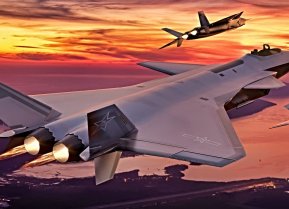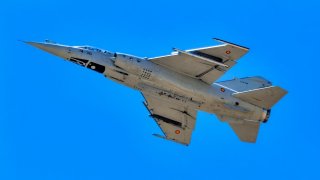France's Dassault F1 Mirage Fighter: No Mere Desert Illusion
The F1 Mirage was first conceptualized in 1963 when the French Air Force (Armée de l'Air) drafted its specifications for an all-weather low-altitude interceptor with supersonic interception capabilities, the ability to use short and rudimentarily-equipped landing strips, and an approach for landing at less than 140 knots (260 kph/161 mph).
The time-honored Merriam-Webster's Dictionary defines the word "mirage" as "an optical (see OPTICAL sense 2a) effect that is sometimes seen at sea, in the desert, or over a hot pavement, that may have the appearance of a pool of water or a mirror in which distant objects are seen inverted, and that is caused by the bending or reflection of rays of light by a layer of heated air of varying density." However, the "Mirage" we'll be discussing in this article is a very real, very solid object. Rather, we're talking about the Dassault Mirage F1 fighter plane.
Dynamic Dassault's Fast French Fighter
This F1 Mirage was built by the Dassault Aviation S.A, a French aviation manufacturer founded in 1931 by engineer and industrialist Marcel Dassault (born Marcel Ferdinand Bloch) under the name Société Anonyme des Avions Marcel Bloch (SAAMB).
The F1 Mirage was first conceptualized in 1963 when the French Air Force (Armée de l'Air) drafted its specifications for an all-weather low-altitude interceptor with supersonic interception capabilities, ability to use short and rudimentarily-equipped landing strips, and approach for landing at less than 140 knots (260 kph/161 mph).
The Mirage made her maiden flight on 23 December 1966 and saw her first deliveries for operational usage on March 14, 1974. The warbird's max speed capability was Mach 2.2 (2,338 kph/1,453 mph)
A total of 720 airframes were built from 1966 to 1992. In addition to serving her native France, the Mirage would be exported to 13 foreign countries; three in Europe, five Middle Eastern, and five African nations.
Assault by the Dassault F1 Mirage
Thanks to the Mirage F1's wide global distribution, the plane would see combat in a number of wars.
The apartheid-era South African Air Force (SAAF) used them heavily in both the ground attack role and an air-to-air role against Cuban Air Force MiG-21 "Fishbed" and MiG-23 "Flogger" pilots in the skies during the South African Border War (aka Namibian War of Independence, aka Angolan Bush War) of 1966-1989.
The Mirage's exact air-to-air kill tally for this conflict is difficult to ascertain. However, it is known that the Mirage – specifically the F1-CZ variant – enabled the SAAF to get its first confirmed aerial victory since the Korean War when, on November 6, 1981, Major JJ Rankin used his warbird's two 30mm cannons to down a MiG-21MF flown by Lt. Danacio Valdez, resulting in KIA status for the Cuban pilot. It is also known that in 23 years of service, only eight South African Mirages were lost due to all causes, and out of those, only one was a combat loss, at the hands of an SA-13 "Gopher" missile.
Meanwhile, the Saddam Hussein-era Iraqi Air Force (IqAF) made good use of its F1EQ variants during the Iran-Iraq War of 1980-1988. As with the SAAF, the IqAF used its Mirages for air-to-ground and air-to-air operations alike.
In the latter role, the Iraqi F1 drivers acquitted themselves fairly well, downing 35 Iranian Air Force aircraft in exchange for a loss of – depending on which source you choose to believe – anywhere from seven to 33 of their own.
Most of the IqAF Mirages' Iranian victims were F-4 Phantoms and F-5E Tiger IIs. Still, at least one lucky Iraqi pilot managed to bag the vaunted F-14 Tomcat, back on November 24, 1981, thus making history as the first-ever aerial kill of the Tomcat.
According to at least one source, the Iraqis may have actually downed a second F-14, making good use of a skillful combination of hit and run tactics and R.530 medium-range missiles.
Most infamously from an American perspective, back on May 17, 1987, an IqAF F1 pilot somehow mistook the U.S. Navy frigate USS Stark (FFG-31) for an Iranian tanker and struck her with an Exocet missile, killing 37 American sailors in the process.
Accidental or not, the Stark would be avenged less than four years later during Operation Desert Storm, whereupon American F-15 Eagle pilots killed 6 IqAF Mirages with no losses; in the process, the F1EQ earned the dubious distinction of being the first Iraqi aircraft to be lost in air combat in the war. Two more Iraqi Mirages were shot down in a single engagement by Royal Saudi Air Force (RSAF) F-15 pilot Capt. Ayehid Salah al-Shamrani, thus making him an instant hero within the Kingdom of Saudi Arabia (KSA).
Where Are They Now?
The F1 Mirage remained in service with the French Air Force until 2014 when they were retired in favor of the Mirage 2000. To the best of my knowledge (and if I'm wrong, please let us know below in the comments section), the last combat usage of the F1 occurred during the 2011 Libyan Civil War, when it was used solely in a ground attack role against anti-Gaddafi rebels.
Today, this venerable 50-something warbird remains in service with the air forces of the Republic of the Congo, Gabon, Iran (ironically and conveniently acquired from Iraq during Desert Storm), post-Gaddafi Libya, and Morocco.
About the Author
Christian D. Orr is a former Air Force officer, Federal law enforcement officer, and private military contractor (with assignments worked in Iraq, the United Arab Emirates, Kosovo, Japan, Germany, and the Pentagon). Chris holds a B.A. in International Relations from the University of Southern California (USC) and an M.A. in Intelligence Studies (concentration in Terrorism Studies) from American Military University (AMU). He has also been published in The Daily Torch and The Journal of Intelligence and Cyber Security. Last but not least, he is a Companion of the Order of the Naval Order of the United States (NOUS).
Image Credit: Shutterstock.


